
A concise biography of Sadguru Shri Dattavadhoot Guruji
Shri Dattavadhoot was born in the Yadwad, a village of Gokak taluk in Belgaum district of Karnataka. He was born to Vishwanath Inamdar and
Indumati on Bhadrapada Shukla Chathurthi, Wednesday i.e., 05-09-1951. There was a religious and spiritual heritage in this house.
He completed his primary and secondary education in Yadwad. He stayed with his grandfather and grandmother in Jamakhandi for 2 years for further
education. In September 1967, his grandfather got the Kannada translation of the biography of Sadguru Sri Brahmachaitanya Maharaj.
His grandfather had seen Shri Maharaj, in Nargund, when he was 12 years old. Reading this book reminded him of that moment and he started reading it
with interest. One day, Shri Dattavadhoot asked him what he kept reading all the time. He took the book from him and saw Shri Maharaj's Photograph in
the book. Immediately, he unknowingly uttered "I have seen Him." Intrigued, He started reading the book and completed reading it in 3 days. It had a tremendous
effect on his mind and completely changed his life. He discontinued his college education and started chanting the RamaNama. On January 10th 1968,
he left Jamkhandi and reached Gondavale, where he stayed for three days and then proceeded to Ujjain on foot. He stayed there for two years and did 1
crore japa of RamaNama. Later, his father came there and took him home. On June 17, 1970, He came to Srimat Jagadguru Sankaracharya Sanskrit Pathashala
at Dharwad. He began studying Sanskrit, Veda and Vedanta from Brahmashree Bhalachandra Shastriji Uppinabetageri. He continued his education in Mysore
and Kudli and in 1973, He came back to Dharwad.
On January 10th 1974, He left home yet again and went to Gondavale to do Namasmaran. On September 23th 1974, Shri Maharaj gave Nama and initiated him
in his dream. Shri Maharaj said, "Chant the mantra ShriRam JayaRam JayajayaRam, you will find peace; I am with you." On the 8th of October, he left
Gondavale at the behest of Shri Maharaj. From there, he reached Omkareshwar, after visiting pilgrim places like Sajjanagada, Chafala, Vayi,
Mahabaleshwar, Shivathara, Alandi, Bhimashankar, Tryambakeshwar and Grishneshwar. Next he started the Narmada Parikrama on Shivratri, stayed at Nemavar
for Chaturmasa, then to Amarakantaka. From there he came to Omkareshwar and completed the Parikrama. From there he returned to Karnataka and stayed at
Kudli Sringeri Math for a year and continued his study of Shankara Bhashya. He went back to Nemavar in 1976 and spent three and a half years there and
did Namasamarana of three and a half crore. Then He came to Gondavale in 1980 and stayed there till 1984. According the wishes of Shri Annasaheb Gadgil,
the then trustee of Gondavale, He came to Hebballi to start Upasana of Shri Maharaj. Since then, He is in Hebballi following and preaching the principles
laid down by Shri Brahmachaitanya Maharaj.
Activities and Events
Shri Dattavadhoot Guruji came to Hebballi on January 26, 1984 and started Upasana as held in Gondavale. Since then, he carried out various activities in and around Hebballi i.e., Hubli-Dharwad and nearby cities, to spread the awareness of the Divine Name (Rama Nama), Sadguru Shri Brahmachaitanya Maharaj's biography and teachings, the significance of spiritual way of life and the Divine presence of Shri Maharaj in Hebballi. He conducted discourses on these topics and gradually spread the awareness in various parts of Karnataka and Maharashthra.

Renovation / Construction of temples
1984 - till date
Shri Maharaj had as different concept of temple (mandir). An University is a centre of worldly knowledge, the Mandir is a
centre of spiritual knowledge. The Mandir is a holy place where one should experience the presence of God.
Keeping this concept in mind,
Shri Guruji started the renovation of the mandir that was built around the Sthirapaduka. He constructed a Rama Mandir (which was completed in 2002)
and also renovated other temples in Hebballi. Shri Guruji also participated in the installation ceremonies of various other temples in Karnataka,
Maharashtra and other states.
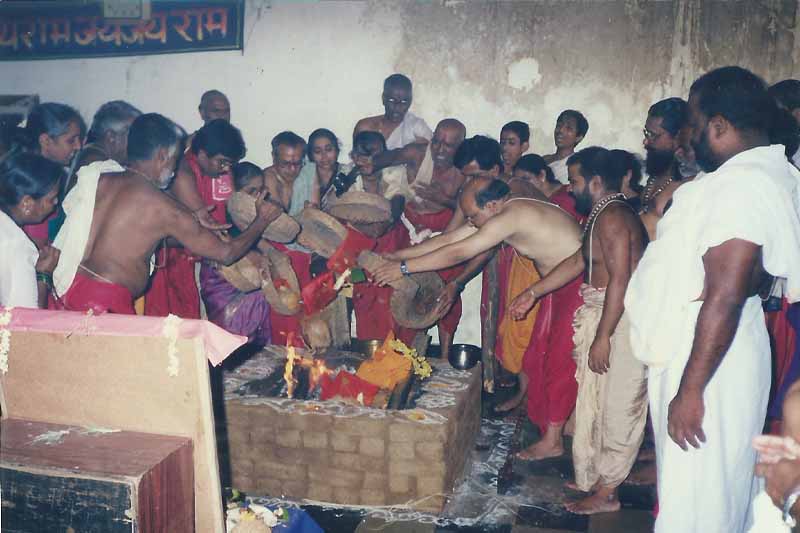
13 Tera Koti Sangata at Navalgund
1986
According to Shri Maharaj, Contemplation is the gateway to God, which can be achieved most easily and naturally through Love towards God.
One can keep company with God through His remembrance. The Divine Name (Nama) is the royal road to hold God fast in memory.
In order to spread the awareness of the importance of chanting of the Divine Name (Namasamarane), Shri Guruji started a resolution (Sankalp) to chant (Japa)
the Divine Name. Devotees from all over Karnataka took part in this resolution. Devotees from Navalgund completed Tera Koti (13 crores) of RamaNama Japa in a period of
... years. To celebrate this holy event, a Sangata Yajna was organized under the guidance of Shri Guruji.

13 Tera Koti Sangata at Dharwad
1995
Following the RamaNama Japa Sankalp, Devotees from Dharwad completed 13 Tera Koti of RamaNama Japa in ... years. To celebrate this holy event, a Sangata Yajna was organized under the guidance of Shri Guruji.

Tera Koti Sangata at Hubli
1996
Following the RamaNama Japa Sankalp, Devotees from Hubli also completed 13 crores of RamaNama Japa in ... years. To celebrate this holy event, a Sangata Yajna was organized under the guidance of Shri Guruji.
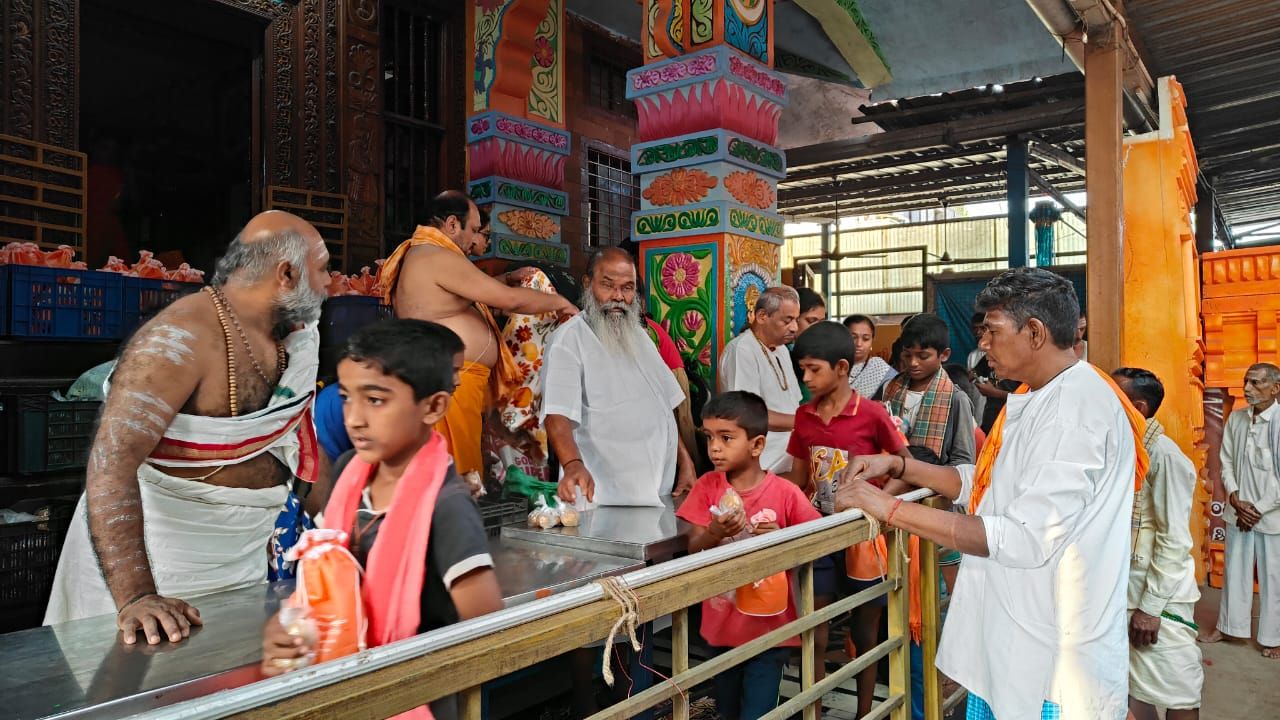
Distributing Rice to the children of Hebballi
1994 - till date
Inspired from Anandashram and keeping Annadana in mind, Shri Guruji started to distribute rice once a month to all the children of Hebballi. On the Amavasya of every month all the children of Hebballi, irrespective of religion, caste and creed assemble near the ashram. All the children are then seated in a hall and they chant the Divine Name for half an hour and then each and every child will be handed over a packet of half kg rice along with sweets. On special occassions, a special dish is also be distributed.
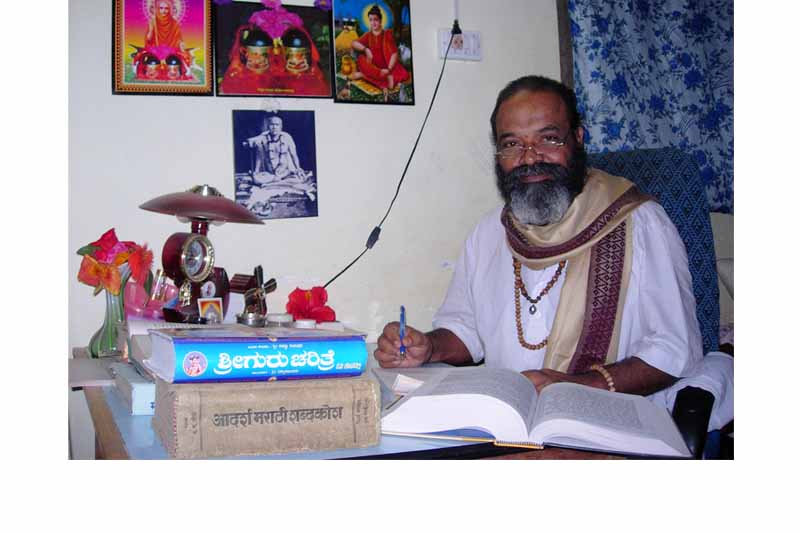
Translation and publishing of Spiritual Books (Granth Sampada)
1989 - till date
Prof. K. V. Belsare (Baba) an ardent devotee of Shri Maharaj was a professor of Philosophy in Mumbai. He dedicated his life to spread the Philosophy
of Shri Maharaj through his numerous discourses and literature (books) in Marathi. In 1989 Shri Guruji, with a view to make this valuable literature available to devotees
in Karnataka, approached Poojya Baba to give him rights to translate his works into Kannada, he happily accepted on one condition that Shri Guruji alone will do the translation.
Since then, Shri Guruji translated and published all of Poojya Baba's books.
Shri Panchvisshe Master, a devotee of Shri Akkalkot Swami, who attended Pooja Baba's discourses regularly
collected the discourses and wrote them down word to word. He later approached Shri Guruji and gave a copy of the manuscript. Shri Guruji started translating the
discourses into Kannada and publish them in three periodicals viz., Namachaitanya (a quarterly magazine), Jnaneshwari Chintandhara (a monthly magazine) and Brahmachaitanya Chintane
(a monthly magazine). Shri Guruji also has translated Sadguru Leelamruta, Gurucharitre, Dasbodh and Jnaneshwari; all of them in ovi form (a style of poetry in Marathi).

Setting up of Upasana Kendras
2006 - 2007
Upasana or devotion means a continuous growth of love of God. There are many ways to achieve this i.e., 1) Namasmarane - Chanting of Divine Name of God,
2) Stothra Patha - Reciting verses in praise of God. 3) Pooja - Worshipping God and decorating Him with ornaments and flowers.
Shri Guruji compiled a simple procedure (vidhana) consisting of RamaRaksha, Hanuman Chalisa recitations, verses of Shri Maharaj and Namasamarane which can be followed by anybody at home daily at anytime
convenient to them. This way everybody participating in the upasana will get used to it and it will be part of their daily routine. Shri Guruji resolved to start
1300 Upasana Kendra (centres) wherein a certain family willing to do upasana in their house will follow the vidhana as compiled. A handbook (Upasana Kaipidi) was also published
and distributed to all these centres so that a consistent procedure is followed by everybody. More than 1300 such centres have been opened in Karnataka and Maharashtra.

Namasamarana Mahasamrajya Pattabhishek
2014 - 2016
In 2014, during Gurupournima Utsav in Hebballi large amount of devotees from all over came to Hebballi to take part in the festival. Seeing the large number of devotees gathered in reverence for Shri Maharaj, Shri Guruji felt that we are all part of a big family or belong to a kingdom of devotees who do Shri Rama Namasamarane as a regular activity in their daily life. Shri Maharaj practised and preached Rama Namasamarane as a Sadhana to achieve God, and all the devotees follow the path laid down by Him. Hence, Shri Maharaj is undoubtedly the Emperor of the kingdom of Namasamarane (Namasamarana Mahasamrajya Chakravarti). Shri Guruji organized a coronation event called Namasamarana Mahasamrajya Pattabhishek in Hubli. A large number of devotees attended the utsav and Shri Guruji felt that the same festival be celebrated in other parts of Karnataka. Many devotees felt the same and it was organized in Shimoga, Hospet, Belgaum, Ghati Subramanya and Honnavar.
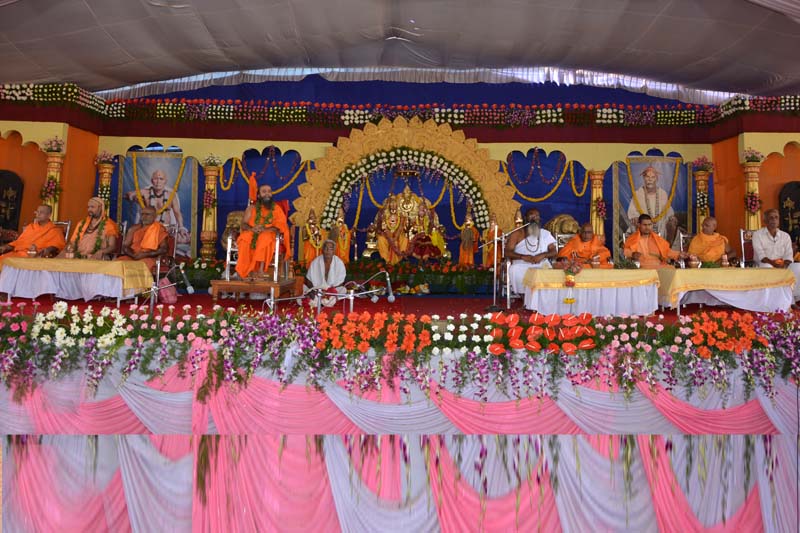
Sthirapaduka Pratishthapana Shatamanotsav
April 12, 2013 - April 22, 2013
Sadguru Shri Brahmachaitanya Maharaj came to Hebballi in April 1909 and installed the Sthirapaduka. Later in December 1913, he attained Mahasamadhi in Gondavale (which is celebrated as Punyatithi every year). Accordingly in 2009, the centenary of the installation of the Sthirapaduka (Sthirapaduka Pratishthapana Shatamanotsav) was to be celebrated. But Shri Guruji wanted to spread the awareness of the Shri Maharaj, Namasamarane and hence resolved to complete 300 Tera Koti by all the devotees in Karnataka, Maharashthra, Madhya Pradesh, Andhra Pradesh, Gujarat etc., and also by devotees residing in other countries to commemorate this holy event. And hence, the event was planned to be held in 2013 coinciding with the centenary of Punyatithi of Shri Maharaj (Punyatithi Shatamanotsav). Accordingly, the Namasamarane was completed and a grand festival was organized in Hebballi. The Shatamanotsav was celebrated for 12 days with people attending from all over India. Spiritual programmes like discourses (Pravachan), reading of spiritual books (Parayan), Bhajan etc., Cultural programmes like Music, Sangeet Seva, Dance, Yakshagana, Drama etc., Religious rituals like Yajna, Pooja etc were organized during this period. Also, Anna Santarpane (Prasadam) was also a main part of this Utsav; daily more than 25,000 people had food during this utsav. As a Grand Finale of this event, flowers were showered by Shri Guruji from a Helicopter over the Sthirapaduka Mandir as well as the place where this Grand Event was organized.

Sadguru Shri Brahmanand Maharaj Punyatithi Shatamanotsav
October 2019
Shri Brahmanand Maharaj was one of Shri Brahmachaitanya Maharaj's prominent disciples. Being from Karnataka, according to Shri Maharaj's wishes, he spread the philosophy of Shri Maharaj and the importance of Namasamarane in Karnataka. He attained Mahasamadhi in Navbag in 1918. Shri Guruji decided to celebrate the centenary of this holy event in 2018 (Sadguru Shri Brahmanand Maharaj Punyatithi Shatamanotsav) and yet again did a Sankalp of 300 Tera Koti Rama Nama Japa. Devotees from Karnataka, Maharashthra and other states took part and completed the Japa. Shri Guruji started the preparation of the Utsav in Hebballi by planning the layout. Then He had to go to Mumbai for a regular heart checkup. After the checkup, His doctor came to conclusion that Shri Guruji needs a bypass surgery. Hence, the event was postponed for one year and was held in 2019. This event was planned with the similar guidelines as the centenary festival celebrated in 2013.
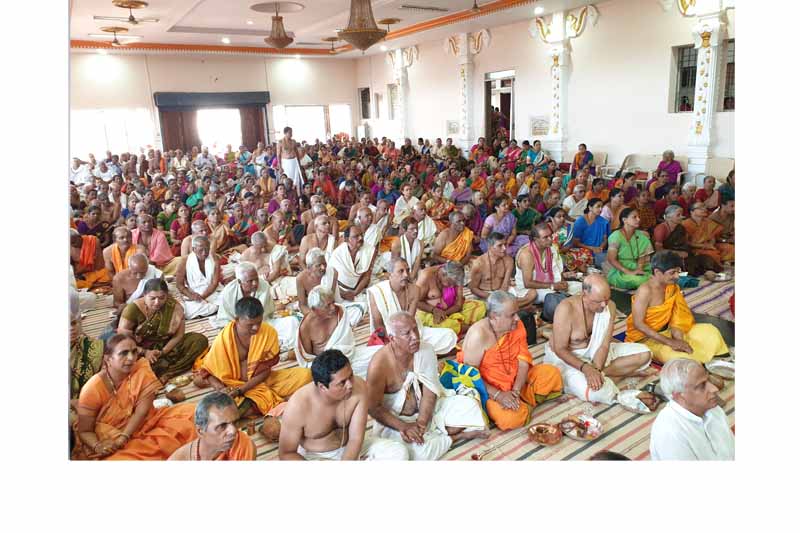
Ajeevana RamaNama Japa Sankalp
2019 - till date
According to Shri Maharaj, "Breathing is common to all humanity so also chanting of the Divine Name is the universal Sadhana for Humanity." One should be able to chant the Divine as easily and
effortlessly as breathing. In order to achieve this, practise of Namasamarane should be done regularly and with discipline. Shri Guruji came up with a plan to involve everybody into doing Namasamarane regularly.
He asked all devotees to make a Life Time Sankalp to do a minimum of 3500 Japa of Shri RamaNama daily. Devotees from all over India have taken part in this sankalp and accordingly doing Namasamarane regularly.
Along with this, one can also make a sankalp of 1.25 crore Japa, 3.5 crore Japa or 13 crore Japa.
Reading philosophical books is essential for a clear notion of the logical basis of our Upasana.
Hence, Shri Gururji also introduced as a part of the sankalp, the reading of the Biography and the Discourses of Shri Maharaj on a daily basis.
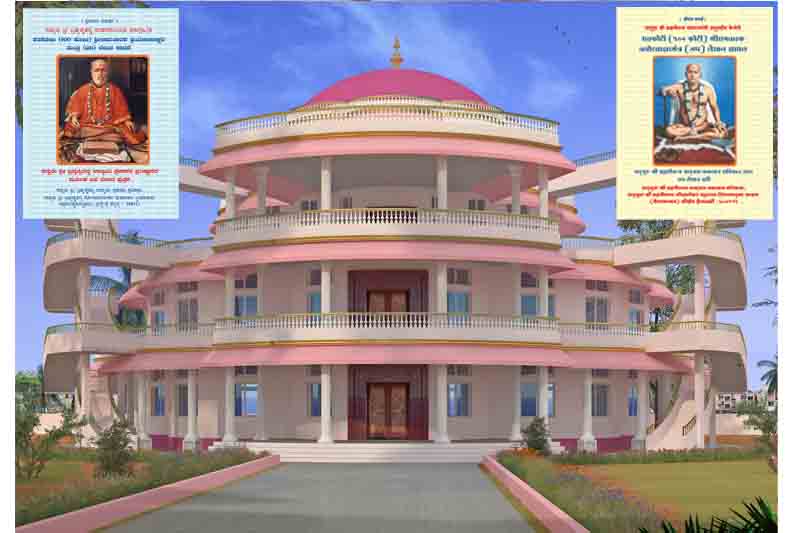
Writing of Shri RamaNama (RamaNama Lekhana)
2020 - till date
Shri Brahmanand Maharaj in an Aarti of Shri Maharaj has written that Shri Maharaj has conveyed the importance of Namasamarane in different forms. One day Shri Guruji had an inspiration that He should start writing of Shri Ramanama as a Sadhana. Hence, he printed and distributed books for writing RamaNama. A total of 1,20,000 books were printed and distributed all over India. Shri Guruji has also designed a temple (Likhit Shri RamaNama Mandir) to keep the books written by the devotees.
